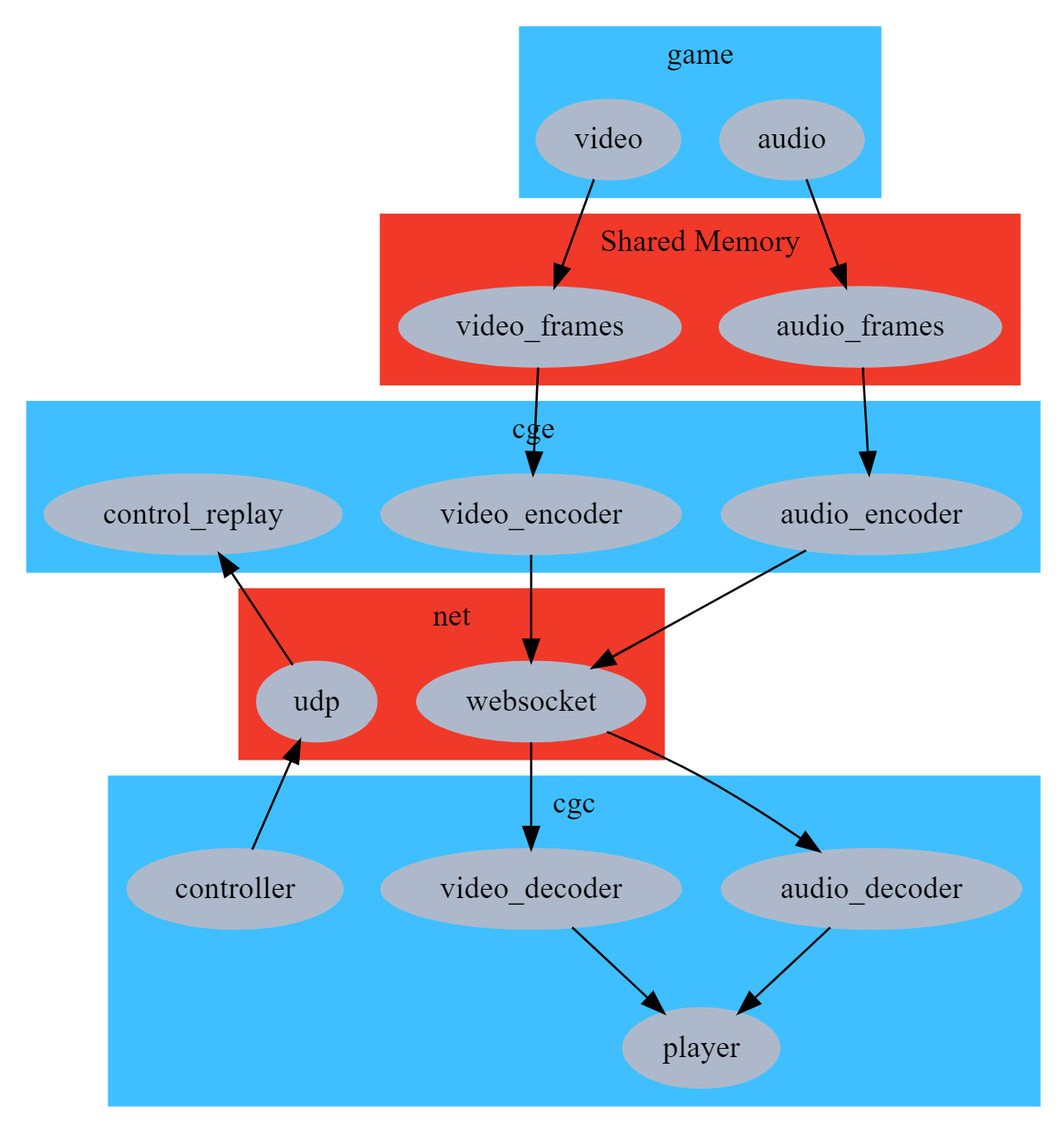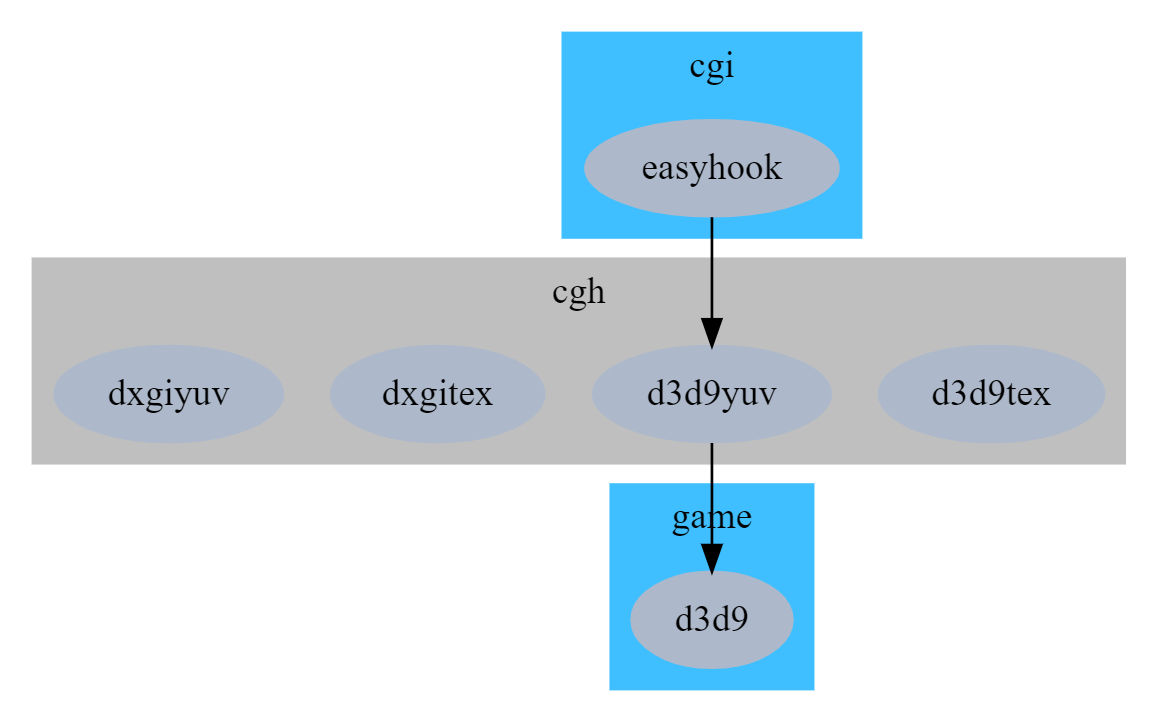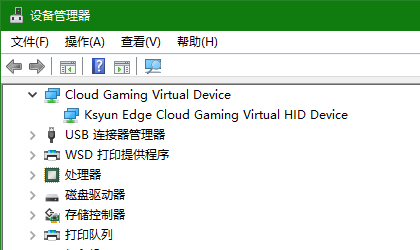鎏光云游戏引擎
简体中文 | English
1. Requirements
Server
| Target | Minimum | Recommended |
|---|---|---|
| System | Windows 7, 8, 8.1, 10 | Windows 10 |
| GPU | NVIDIA GPU | RTX 1080Ti, GTX 2070S tested |
| Software | GeForce Experience | latest GeForce Experience |
| Driver | GeForce Game Ready Driver | latest GeForce Game Ready Driver |
- If you don't have an NVIDIA GPU, select --enable-nvenc=false to run
cge.
Client
| Target | Minimum | Recommended |
|---|---|---|
| System | Windows 7, 8, 8.1, 10 | Windows 10 |
| CPU | ANY | amd64 |
2. Basic
3. QuickStart
All the componets listed below, will be open source by time.
cge
The Cloud Gaming Engine. A precompiled binary is here.
You can launch cge directly, which will apply the following options:
audio-bitrate: 128000
audio-codec: libopus
bind-address: ::
control-port: 8080
donot-present: false
enable-nvenc: true
keyboard-replay: none
stream-port: 8080
video-bitrate: 1000000
video-codec: h264
video-gop: 180
video-preset: llhp
video-quality: 23
Run cge --help to see all options:
Usage:
-h [ --help ] produce help message
--audio-bitrate arg (=128000) set audio bitrate
--audio-codec arg (=libopus) set audio codec, can be one of {libopus, opus,
aac}
--bind-address arg (=::) set bind address for listening, eg: 0.0.0.0
--control-port arg (=8080) set the UDP port for control flow
--donot-present arg (=0) Tell cgh don't present
--enable-nvenc arg (=1) Enable nvenc
--keyboard-replay arg (=none) keyboard replay method, can be one of {none,
cgvhid}
--stream-port arg (=8080) set the websocket port for streaming, if port
is 0, disable stream out via network. Capture
and encode picture directly at startup but not
on connection establishing, and never stop
this until cge exit. stream port is not same
as control port, this port is only for media
output.
--video-bitrate arg (=1000000) set video bitrate
--video-codec arg (=h264) set video codec, can be one of {h264, h265}
--video-gop arg (=180) set video gop
--video-preset arg
--video-quality arg (=23) set video quality, lower is better, available
range is 0-51, 0 is lossless
You can press Ctrl+C to stop it gracefully.
cgh
Some hook dlls for capturing pictures from D3D game.
Download here
cgi
A tool for injecting hook dll into game process.
Allowed options:
-h [ --help ] Produce help message
-d [ --dynamic ] arg Use dynamic injecting
-e [ --exec ] arg Path of the executable
-a [ --arg ] arg Arguments of the executable
-c [ --cd ] arg Current directory for the executable
-i [ --imagename ] arg Image name of the process being injected.
-w [ --wait ] arg (=1,000) Wait before injecting. unit: ms
--lx86 arg Path of x86 library path
--lx64 arg Path of x64 library path
cgvhid
Cloud gameing Virtual HID driver. For replaying controller event on server. Download here
cgvidd
Cloud gameing Virtual Indirect Display Driver. For capturing screen on server.
video_source
A tool for testing. Download here. Just run it, and it will generate simple pictures and write them as video frames to shared memory, then notify cge to fetch. You can use cgc to see these pictures.
cgc
A testing version client to work with cge. Download h264 version here and h265 version here.
Usage:
--server (=127.0.0.1) set server address
--port (=8080) set server port
--hw_decode hardware decoder, only support d3d11va now.
cgs
A WebRTC server works together with cge, to serve web clients.
4. Setting Up Your Build Environment
4.1 VS2019
Install VS2019 with ATL, CLang.
CLang/LLVM x64 is also needed, while VS may only has CLang x86.
4.2 Boost
Install Boost and set BOOST_ROOT environment variable to install directory. Details
Boost compile command:
.\b2 --address-model=64 runtime-link=static
4.3 FFmpeg
Put FFmpeg header files in deps\include, and the libs in deps\lib.
4.4 SDL
Put SDL2 header files in deps\include, and the libs in deps\lib.
The same as SDL_ttf 2.0 and SDL_net 2.0.
4.5 WDK
Required by cgvhid, cgvidd.
5. Building and Testing
Open each solution file with VS, and press F7.
Testing steps:
-
Run
cgeon server. -
Run
video_sourceon server. -
Run
cgc --server=<server_address>on anther PC as long as it can access the server over the network.
Test with games:
Assume you want to test USF4.
-
Install
cgvhidon server. -
Run
cge --keyboard-replay=cgvhidon server. -
Run
cgi -d true -e SSFIV.exe -i SSFIV.exe --lx86 .\d3d9yuv.dllon server. -
Run
cgc --server=<server_address>on anther PC as long as it can access the server over the network.
Note that only support D3D9 games now, will support D3D11 games soon.
6. Contact Us
WeChat: UMUTech


